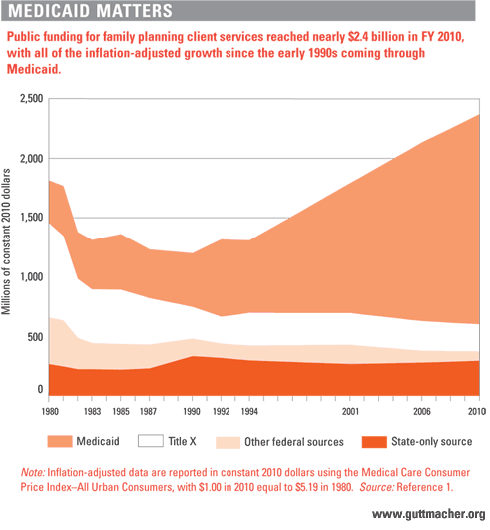Public funding for family planning services reached nearly $2.4 billion in fiscal year 2010, according to new Guttmacher Institute research. Medicaid, the joint federal-state insurance program for millions of low-income individuals and families, accounted for 75% ($1.8 billion) of the total, compared with 12% for state-only sources and 10% for the Title X federal family planning program.

Medicaid has been responsible for almost all of the growth in publicly funded family planning services since the early 1990s. Under Medicaid, family planning services—including the provision of contraceptive drugs and devices, client counseling and education, and related tests and treatment for issues such as sexually transmitted infections—are covered for enrollees.
"The recent growth in family planning expenditures through Medicaid mirrors broader growth in this huge public insurance program, brought on in significant part by the recessions of the past decade, during which many Americans lost employer-based private insurance coverage," says Adam Sonfield, co-author of the new study. "Medicaid has performed admirably as a social safety-net program for low-income Americans, helping millions of women and their partners plan and space their childbearing even in times of economic hardship."
As Guttmacher has previously documented, publicly funded family planning services play a crucial role in improving maternal and child health, helping women and couples achieve their fundamental childbearing goals and achieve economic security for themselves and their children. These efforts save almost $4 for every $1 invested and help avert almost two million unintended pregnancies per year, which would otherwise have resulted in 860,000 unintended births and 810,000 abortions. Without these services, the number of unintended pregnancies and abortions occurring in the United States would be nearly two-thirds higher among women overall and among teens; the number of unintended pregnancies among poor women would nearly double.
Although Medicaid has become increasingly central in financing the national family planning effort, it cannot succeed on its own. The Title X program, state-only funding sources and several federal block grants have long played important financial roles and continue to do so in many states. Family planning providers value these other funding sources because of their flexibility.
"Family planning providers need programs such as Title X to fill out the package of necessary services beyond what Medicaid will cover and to provide services to populations that Medicaid is unable to serve," says Rachel Benson Gold, co-author of the new study. "In addition, Title X sets nationwide standards for publicly supported family planning services, ensuring that services are comprehensive, voluntary, confidential and affordable."
Notably, the study’s findings for fiscal year 2010 on levels of public funding for family planning predate a wave of ideologically and fiscally motivated attacks by conservative federal and state policymakers in 2011 on family planning programs and providers and, more broadly, on Medicaid. Those attacks have the potential to undermine the family planning safety net in specific states and nationwide.
Findings on other services:
The study found that public spending on sterilization services in 2010 totaled $93 million, 95% of which was through Medicaid. It also shows that states spent $68 million on about 181,000 abortion procedures for low-income women, virtually all of it in the 17 states that use their own funds to pay for most or all medically necessary abortions provided to Medicaid recipients. The federal government, which restricts funding to cases of life endangerment, rape and incest, contributed to the cost of only 331 of those procedures.
Click here to read "Public Funding for Family Planning, Sterilization and Abortion Services, FY 1980–2010," by Adam Sonfield and Rachel Benson Gold
Also see these additional resources:
Facts on Publicly Funded Contraceptive Services in the United States
Political Tug-of-War Over Medicaid Could Have Major Implications for Reproductive Health Care